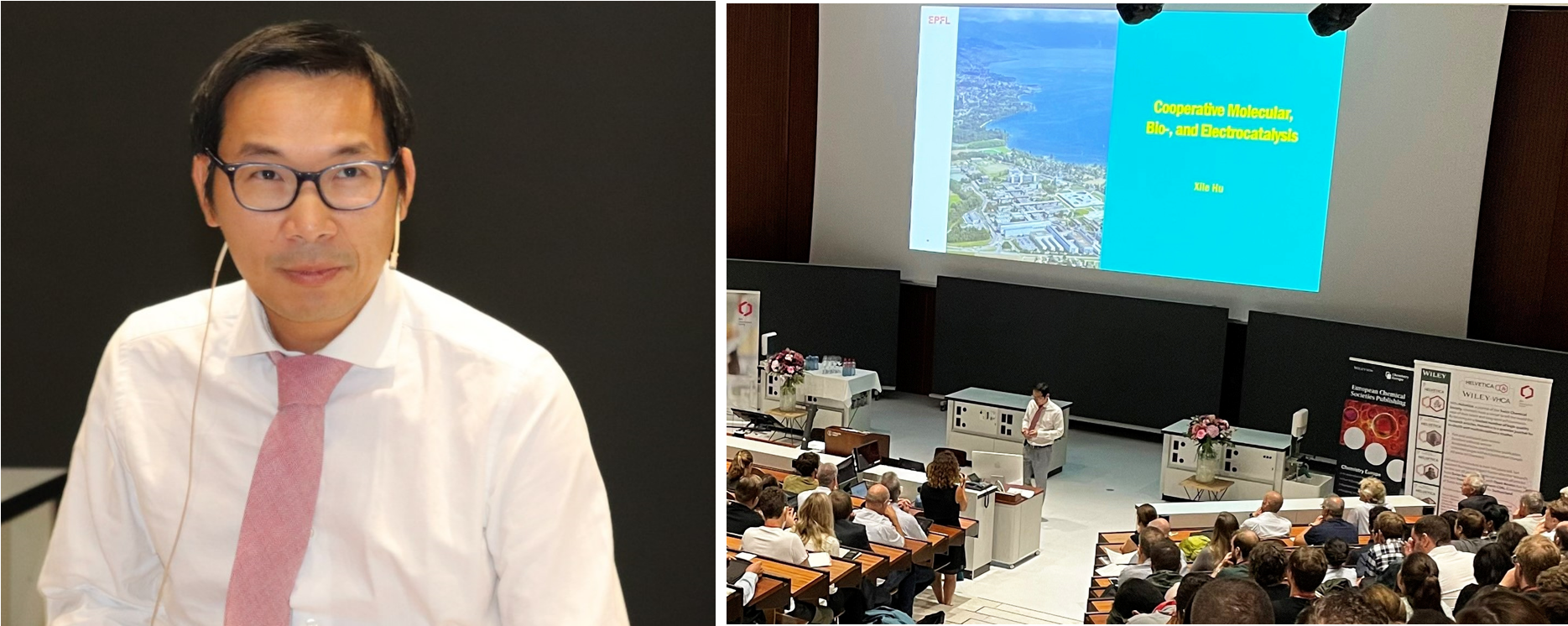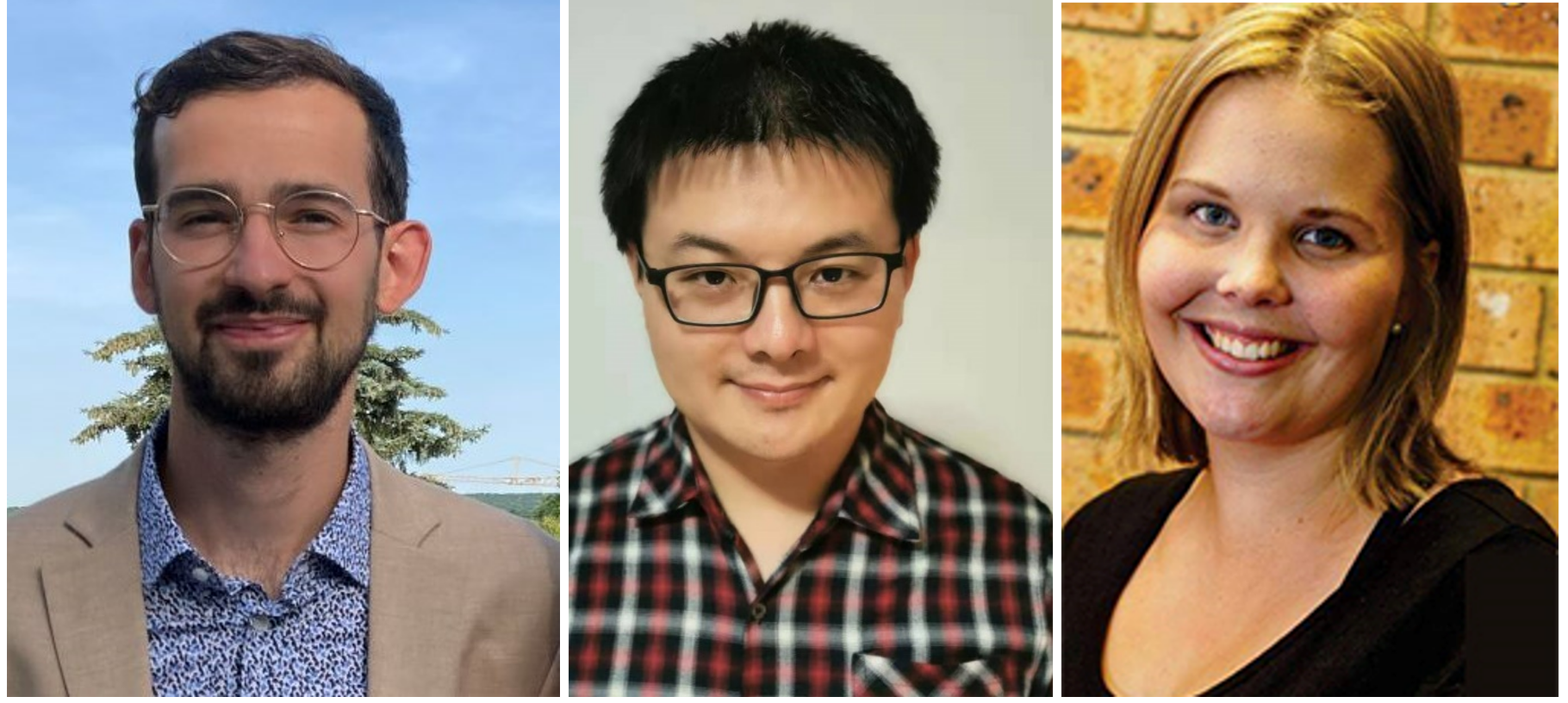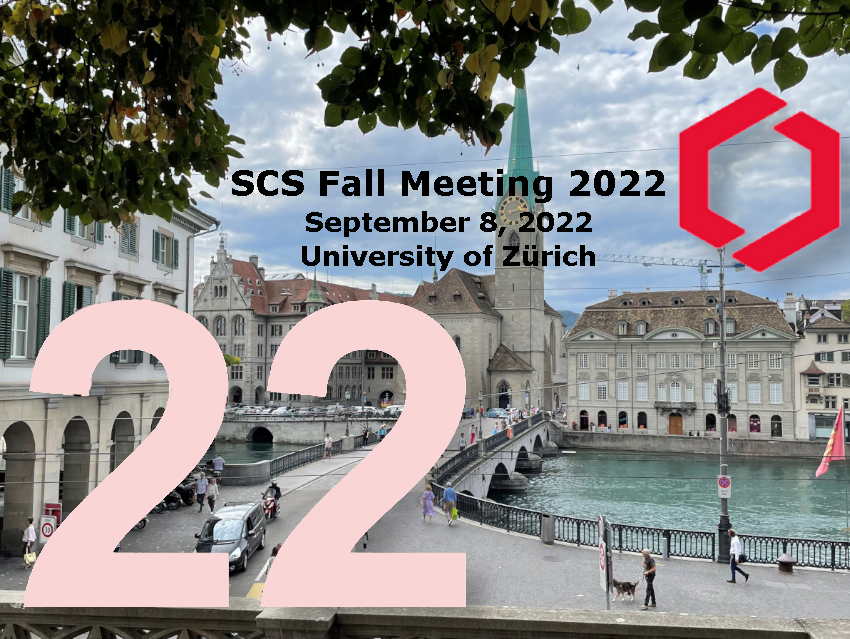After two years of online meetings, the Swiss Chemical Society (SCS) held its Fall Meeting in person again. The meeting, which is one of the largest annual research conferences in Switzerland, took place at the Lichthof and lecture halls of the Department of Chemistry at the beautifully green Irchel Campus of the University of Zurich. The day started and ended in the crowded auditorium of the Faculty of Chemistry with award ceremonies and award lectures. In between, there were nine parallel sessions with more than 100 oral contributions on the whole range of chemistry, over 350 posters, and an exhibition that offered a lot to discover. During the lunch break, the youngSCS reported on their activities and introduced their new board.
 Lichthof and crowded award lecture.
Lichthof and crowded award lecture.
Research with Anarchical Traits
The Paracelsus Prize is the highest honor of the SCS and recognizes outstanding scientific research in the field of chemistry at an international level. The award includes CHF 20,000 and a medal in gold. Antonio Togni, Professor at the Swiss Federal Institute of Technology (ETH) Zurich, has been awarded the Paracelsus Prize 2022 [1] and held the Paracelsus Prize Lecture at the meeting.
Antonio Togni is honored “for his groundbreaking contributions to organic, inorganic, organometallic chemistry and catalysis both in industry and academia as well as for his inspiring approaches to teaching and education.” [2] His research interests include direct electrophilic trifluoromethylations using hypervalent-iodine-based reagents (Togni reagents) and ferrocene-based catalysts, as well as homogenous catalysis and the preparation of unprecedented ligands, such as Josiphos and derivatives.
“For the sake of making molecules,” was the title of his talk. If anyone feels provoked by the title, he started, “then I already achieved a goal today”. And he showed his subtitle: “Making molecules has been my career strategy for over 40 years.”
His talk offered a kind of career story based on the synthesis histories of eight selected molecules. The molecules, he said, he has chosen at random; the Togni reagents and Josiphos are not among them. Especially in his time at Ciba-Geigy Ltd., Basel, Switzerland, quite a few of these syntheses were done without the knowledge of his superiors, out of pure curiosity and enthusiasm.
The eight molecules included for example: 4Me-APPA (CGP 37849 or DL-(E)-2-amino-4-methyl-5-phosphono-3-pentenoic acid or 4-methyl-APPA (molecule 1 pictured below), oxovanadium(IV) bis((1R)-3-(heptafluorobutyl)camphorate [3] (molecule 5), and [R–3 b(NCMe)2] with (R)-3 b = dichloro[4R,5R-2,2-dimethyl-α,α,α′,α′-tetra(1-naphthyl)-1,3-dioxolane-4,5-dimethanolato(2-)-O,O′]titanium [4] (molecule 6). Many of them show pharmacological or catalytic properties.
In his talk, Antonio Togni touched on several research areas of chemical synthesis. This breadth could be described as chaotic, but this is not due to his inability to plan the work of his research group, he said; rather, Antonio Togni believes “that academic research, viewed as a mean of educating and forming young researchers, should resist the temptation towards an increasing projectification, milestone mentality, the myth of societal relevance, and consciously aim for a more anarchical trait.”
Academic research, as he understands it, is about educating students, especially Ph.D. students, to become independent thinkers. He can be seen as a role model for independent thinking, and in retrospect, his “chaotic,” interest-driven research was an asset to him and his research.

Antonio Togni’s stories touch on eight selected molecules and several research areas of chemical synthesis.
New Tools for Catalyst Design
Xile Hu, Professor at Ecole Polytechnique Fédérale de Lausanne (EPFL), is awarded the Green & Sustainable Chemistry Award 2022 “for his outstanding interdisciplinary research program to develop catalysis for sustainable synthesis of added-value chemicals and for cost-effective production of solar and electric fuels.” [5] The prize is endowed by Syngenta Crop Protection AG and wants to encourage and recognize young academic investigators to contribute to the development of sustainable chemical methodologies and technologies.
Xile Hu started his award lecture humorously. He did a Google search to find out what is meant by the buzzwords “green” and “sustainable”. The result—green liquids in various flasks and a flask made of plants—convinced him that he understands nothing about this—he could not find colored solutions in his lab and has no talent for growing plants—and, therefore, he decided he could “only” talk about chemistry. Since his research focuses on catalysis, he wanted to talk about catalysis.
However, of course, Xile Hu’s talk made clear that catalysis plays an important role in green and sustainable chemistry. His goal is to develop catalysts composed of Earth-abundant elements that catalyze organic syntheses, electrochemical water splitting, or CO2 reduction. He is also involved in fuel cell catalysis and the development of synthetic models for the active site of metalloenzymes. The concept of cooperative catalysis, in which multiple chemical entities work together to catalyze a chemical process, can bring about new tools for catalyst design and overcome the limitations of single-site catalysis. Xile Hu presented examples from his research in molecular, bio, and heterogeneous (electro)catalysis.
An example was [Fe] hydrogenase, an efficient biological hydrogenation catalyst [6]. The mechanism of H2 activation by [Fe] hydrogenase is unclear. Xile Hu and his team reconstructed [Fe] hydrogenase from an apoenzyme and created a semisynthetic enzyme. Using this model and density functional theory calculations, he proposes a mechanism in which the 2-hydroxy group is deprotonated before serving as an internal base for heterolytic H2 cleavage.
Based on these findings from the biomimetic chemistry of [Fe] hydrogenase, he developed an Mn(I) model of [Fe] hydrogenase [7]. This complex shows the highest activity and broadest range of applications in catalytic hydrogenation among known mimics. This unique activity enabled an enantioselective relay hydrogenation of benzoxazinones and benzoxazines by Mn-catalyzed hydrogenation of an enantiomerically pure hydride acceptor, followed by Lewis acid-catalyzed asymmetric hydride transfer.
 Xile Hu shows that cooperative catalysis is a universal design principle for all types of catalysts.
Xile Hu shows that cooperative catalysis is a universal design principle for all types of catalysts.
Best Articles by Ph.D. Students and Postdocs
Traditionally, the journal Helvetica Chimica Acta awards the “Helvetica Prize” at the Fall Meeting to recognize outstanding publications in the journal by young researchers in Switzerland. This year, for the fourth time, the best published papers from Ph.D. students and postdocs were awarded.
The first prize, worth CHF 1,000, went to Jordan De Jesus Silva, a Ph.D. student at Christophe Copéret’s group, ETH Zurich, for the article: Development and Molecular Understanding of a Pd-Catalyzed Cyanation of Aryl Boronic Acids Enabled by High-Throughput Experimentation and Data Analysis [8].
In his article, Jordan De Jesus Silva describes synthetic methods for the palladium-catalyzed cyanation of arylboronic acids using bench-stable and nontoxic N-cyanosuccinimides. The yield is determined primarily by the σ-donation of the ligand, the π-acidity, and the sterics. The ligands were classified into the groups monophosphines, bisphosphines, and others. For the monophosphines, the reaction yield increases for strong σ-donating and weak π-accepting ligands with flexible pendant substituents. For bisphosphines, the yield correlates primarily with ligand flexibility. The reaction can be applied to a broader range of substrates and showed good tolerance to functional groups, especially boronic acids with electron-withdrawing substituents.
The second prize, worth CHF 500, went to Weilong Liu and Emma E. Watson, both postdocs in the group of Nicolas Winssinger at the University of Geneva, for the review article: Photocatalysis in Chemical Biology: Extending the Scope of Optochemical Control and Towards New Frontiers in Semisynthetic Bioconjugates and Biocatalysis [9]. The three award winners presented their work in short presentations.
 Helvetica Prize awardees (left to right): Jordan De Jesus Silva, ETH Zurich, Weilong Liu and Emma E. Watson, both University of Geneva.
Helvetica Prize awardees (left to right): Jordan De Jesus Silva, ETH Zurich, Weilong Liu and Emma E. Watson, both University of Geneva.
References
[1] Paracelsus Prize 2022, ChemistryViews 2022.
[2] Paracelsus Prize, SCS website (accessed September 11, 2022)
[3] A Togni, G Rist, G Rihs, A Schweiger, EPR, proton and carbon-13 ENDOR, nitrogen-14 ESEEM, and x-ray crystallographic studies of oxovanadium(IV) bis((1R)-3-(heptafluorobutyryl)camphor): a catalyst for asymmetric hetero Diels-Alder reactions, J. Am. Chem. Soc. 1993, 115 (5), 1908–1915. https://doi.org/10.1021/ja00058a041
[4] Lukas Hintermann, Antonio Togni, Catalytic Enantioselective Fluorination of β-Ketoesters, Angew. Chem. Int. Ed. 2000. https://doi.org/10.1002/1521-3773(20001201)39:23<4359::AID-ANIE4359>3.0.CO;2-P
[5] Green & Sustainable Chemistry Award, SCS website (accessed September 11, 2022)
[6] Seigo Shima, Dafa Chen, Tao Xu, Matthew D. Wodrich, Takashi Fujishiro, Katherine M. Schultz, Jörg Kahnt, Kenichi Ataka, Xile Hu, Reconstitution of [Fe]-hydrogenase using model complexes, Nat. Chem. 2015, 7, 995–1002. https://doi.org/10.1038/nchem.2382
[7] Hui-Jie Pan, Xile Hu, Biomimetic Hydrogenation Catalyzed by a Manganese Model of [Fe]-Hydrogenase, Angew. Chem. Int. Ed. 2019. https://doi.org/10.1002/ange.201914377
[8] Jordan De Jesus Silva, Niccolò Bartalucci, Benson Jelier, Samantha Grosslight, Tobias Gensch, Claas Schünemann, Bernd Müller, Paul C. J. Kamer, Christophe Copéret, Matthew S. Sigman, Antonio Togni, Development and Molecular Understanding of a Pd-Catalyzed Cyanation of Aryl Boronic Acids Enabled by High-Throughput Experimentation and Data Analysis, Helv. Chim. Acta 2021. https://doi.org/10.1002/hlca.202100200
[9] Weilong Liu, Emma E. Watson, Nicolas Winssinger, Photocatalysis in Chemical Biology: Extending the Scope of Optochemical Control and Towards New Frontiers in Semisynthetic Bioconjugates and Biocatalysis, Helv. Chim. Acta 2021. https://doi.org/10.1002/hlca.202100179




